#there's just something so appealing about the way that mary marvel is depicted
Explore tagged Tumblr posts
Photo
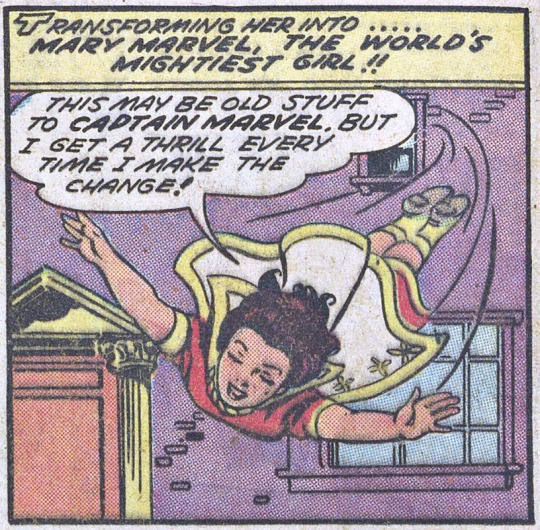
Wow Comics #12
#mary marvel#mary bromfield#wow comics#fawcett comics#golden age of comic books#there's just something so appealing about the way that mary marvel is depicted#the same as captain marvel jr...#there's a youthfulness about them that reminds me of the children from neverland#and whenever they transform -- there's the feeling that they're being set free#which is absent from billy's/captain's transformation#anyway...
14 notes
·
View notes
Text
gosh thinking about how Mary’s comic vine page says something like ‘Captain Marvel was a popular character so it was only a matter of time until they made a girl spin-off to appeal to the female market’ which is just not true or at least really misleading phrasing.
like I’m pretty sure that Mary was not only the first female spin-off of a male character in comics ever but that she was the first teen girl comics hero ever and that her team-up with Bulletgirl was the first all-girl hero team-up. like I think it’s easy to see her creation as inevitable from our modern perspective when there are lots of spin-offs and legacy characters but I think that undersells how important she was historically and how long she’s existed.
as an example, Mary was introduced as Billy’s long-lost twin sister. after Fawcett Comics shut down Otto Binder, a co-creator of Mary, went to work for DC where he co-created Supergirl who was introduced as Clark’s long-lost cousin. a lot of the Superman books from that time were influenced by the Marvel Family books including the family aspect. we simply don’t get Supergirl in the way that we did without Mary having come first.
like sure if Mary hadn’t been created in 1942 then somebody else probably would have been eventually and they would have gotten Mary’s firsts… but they didn’t. Mary did. and that’s significant because her portrayal influenced the depiction of girl heroes in the 40s which is significant cause that’s not like unrelated to our modern comics.
I just think it’s ahistorical to act as though Mary was simply an inevitable character.
anyway, this year’s her 80th anniversary so I gotta remember to do something for that.
5 notes
·
View notes
Note
Who are your favourite DD villains? Fisk, Bullseye and Mr Fear all sound brilliant from what I know of them, but are there any others with similarly iconic influence on Matt?
There are! Daredevil comics aren’t known for their well-crafted villains to the extent that, say, Spider-Man or Batman comics are, but I really enjoy a lot of Matt’s rogues gallery. Fisk and Bullseye are probably the two biggest names, but there are many others who have had major impacts on his life, and the Marvel Universe in general, over the years. Here are some of the most notable DD villains, in my opinion:
Gladiator (Melvin Potter) is a major antagonist who, over the years has become arguably one of the most nuanced and interesting Daredevil characters. I wrote a longer post about him, way back when we thought we might actually get a Gladiator origin story in the Netflix show, but in general, a lot of his lasting appeal comes from the complexity of his character. When he was first introduced in Daredevil vol. 1 #18 he was a pretty standard Silver Age villain: a guy with semi-logical origin story, a funky costume, and a penchant for monologuing. Specifically, Melvin Potter was the owner of a costume store who was sick of being disrespected by his customers, and so decided to make a name for himself by attacking people with spinning blades.
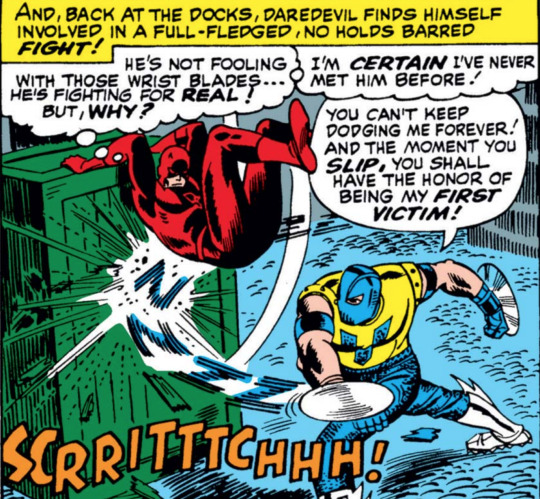
[ID: A panel from Lee’s Daredevil run. Daredevil is battling the Gladiator. Daredevil hoists himself up on a big crate to dodge one of the Gladiator’s spinning wrist blades.]
Matt: “He’s not fooling with those wrist blades… he’s fighting for real! But, why? I’m certain I’ve never met him before!”
Melvin: “You can’t keep dodging me forever! And the moment you slip, you shall have the honor of being my first victim!”
Daredevil vol. 1 #18 by Stan Lee, John Romita, and Sam Rosen
Over the years, various writers have worked hard to add nuance to his character. Despite his fearsome appearance and goal of gaining respect, most early Gladiator stories involve Melvin being manipulated by stronger, smarter supervillains. Later, he becomes even more sympathetic: a dangerous killer who, at heart, is gentle and naive and hates when he loses control and hurts people. This creates an inherent discord in his character that adds an emotional hook to all of his stories. Matt tries to help him, and Melvin is grateful for Matt’s friendship and returns that favor when he can, but sometimes they end up having to fight each other. Essentially, Melvin’s story is the relentless tragedy of a man who wants to live a peaceful life but keeps falling victim to his own demons and the cruelty of the world around him.
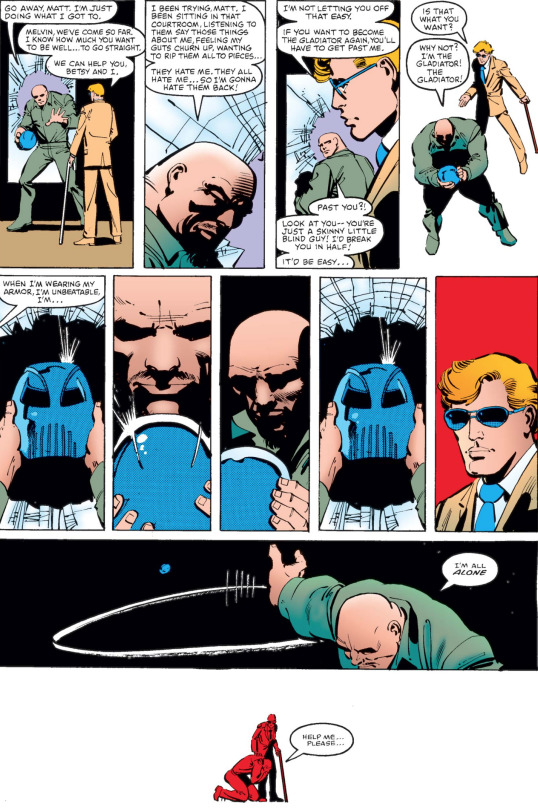
[ID: A page from Miller’s Daredevil run. Matt Murdock, in civvies (a tan suit and blue tie) confronts Melvin Potter, who is in a prison uniform and holding his Gladiator helmet.]
Matt: “Melvin, we’ve come so far. I know how much you want to be well… to go straight. We can help you, Betsy and I.”
Melvin: “I been trying, Matt. I been sitting in that courtroom, listening to them say those things about me, feeling my guts churn up, wanting to rip them all to pieces… They hate me. They all hate me… so I’m gonna hate them back!”
Matt: “I’m not letting you off that easy. If you want to become the Gladiator again, you’ll have to get past me.”
Melvin: “Past you?! Look at you– you’re just a skinny little blind guy! I’d break you in half! It’d be easy…”
Matt: “Is that what you want?”
Melvin: “Why not? I’m the Gladiator! The Gladiator! When I’m wearing my armor, I’m unbeatable, I’m…”
[ID: Melvin throws the helmet and falls to his knees.]
Melvin: “I’m all alone. Help me… please…”
Daredevil vol. 1 #173 by Frank Miller, Klaus Janson, and Glynis Wein
This complicated and heartwrenching characterization has helped Melvin to remain a fresh and popular antagonist (anti-hero, even) and a regular guest in Daredevil. He is one of several characters who complicates the hero/villain dichotomy, and thereby both emphasizes and challenges Matt’s own heroism.
Typhoid Mary/Mary Walker is another one of the more famous Daredevil villains, and someone who has had a significant impact on Matt’s story over the years. I wrote a longer post on her as well. Female antagonists in particular seem to suffer from a variety of weaknesses in their depictions, and Typhoid– as a sexual character by nature, as well as someone who plays upon “crazy” villain tropes– has had her share of not great depictions over the years. However, at her core, she is a wonderfully compelling character and a dangerous villain who is literally multifaceted by design. Even moreso than Melvin Potter, Mary plays upon the concept of a good person who is powerless to prevent themself from doing violent things– in Mary’s case, through genuinely having multiple psyches inhabiting one body. She is in constant conflict with herself, as gentle Mary and bloodthirsty Typhoid battle for dominance. As much as she is an antagonist to Matt and the other heroes whose paths she crosses, she is her own arch-enemy.
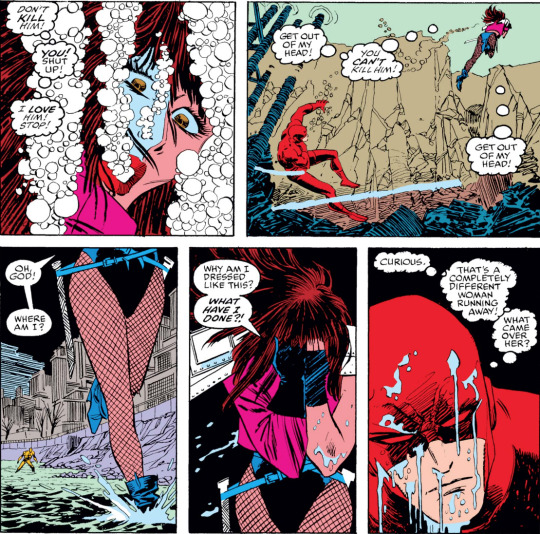
[ID: An excerpt from Nocenti’s Daredevil run. Typhoid Mary and Daredevil are both underwater, in the East River. Mary looked panicked partway through strangling Daredevil, and flees out of the water.]
Mary/Typhoid: “Don’t kill him! You! Shut up! I love him! Stop! Get out of my head! You can’t kill him! Get out of my head! Oh, god! Where am I? Why am I dressed like this? What have I done?!”
Matt: “Curious. That’s a completely different woman running away! What came over her?”
Daredevil vol. 1 #256 by Ann Nocenti, John Romita Jr., and Christie Scheele
Matt’s dealings with Mary have brought about some of the more unheroic moments in his career. In Joe Kelly’s attempt to integrate the Man Without Fear-verse origin story into the 616 universe, he proposed that Matt nearly killed Mary on his first superhero outing. When Typhoid, in her introductory arc, is hired to seduce Matt, it works– he cheats on Karen with her. Later, when attempting to bring down the Kingpin’s empire, Matt removes Mary from the equation by sleeping with her to get her guard down and then forging documents to have her locked away in a psychiatric hospital. She hits all of his weak points: as Mary, she is a victim who needs rescuing… and an attractive one at that. As Typhoid, she is a dangerous enemy who must be stopped. In addition to her skill with weapons, she has all kinds of awesome psychic powers– including, most notably, pyrokinesis– and something about her physiology messes with Matt’s senses and makes her difficult to fight. She is a challenge on every level, and in many ways, Matt serves the same purpose for her– Mary (and, arguably, Typhoid as well) accidentally falls in love with him, representing a loss of power and control that she can’t stand.
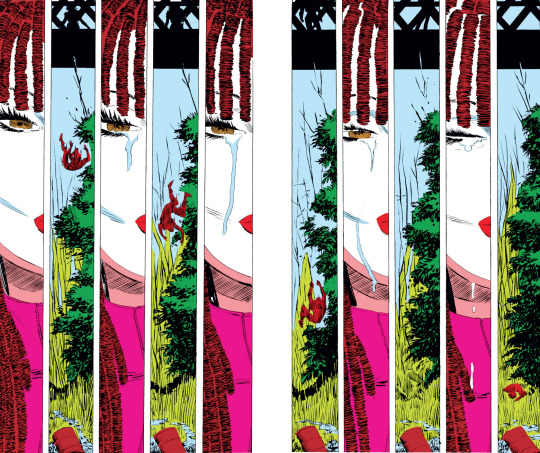
[ID: Excerpt from Nocenti’s Daredevil run. A series of panels alternating between Daredevil falling off a bridge and a tear sliding down Typhoid Mary’s cheek.]
Daredevil vol. 1 #260 by Ann Nocenti, John Romita Jr., and Christie Scheele
The Hand I love the Hand– which is to say, I love the Chaste, and part of why I love the Chaste is because I love their rivalry with the Hand. On some levels, the Hand are your standard Big Bad Secret Organization, but I also find them to be a lot of fun, and they have been a significant force in Daredevil comics since they were introduced. The Hand are key players in Miller’s updated version of Matt’s origin, which introduced Stick and gave him a purpose for training Matt. They also had a huge role in Elektra’s origin, since her attempt to singlehandedly bring them down from the inside led to her becoming an assassin. And of course, Matt’s role as leader of the Hand and temporary vessel for their patron demon, the Beast, was a defining moment in recent DD comics and a low point of Matt’s career. The Hand are dangerous because they are vast, and their high-ranking members have all kinds of cool powers, which I love. And there’s also a certain amount of weakness and dysfunction to the Hand that makes them appealing. They are a once-great organization relegated to being mercenaries-for-hire. Their low-ranking members are fairly weak– as Matt quips in Volume 1 #380, “a little harsh language and [they’re] up in smoke!” They were led by a Skrull (disguised as Elektra) for a while, and didn’t even notice. Arguably their most dangerous enemy, Master Izo, mostly just bothers them with Hand puns.
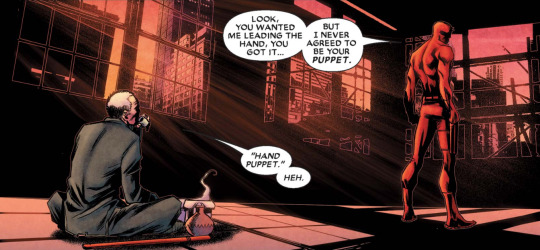
[ID: A panel from Diggle’s Daredevil run. Daredevil, seen from the back, is standing in an empty room. The light from the sunset streams in through the windows. Izo is sitting behind him on the floor, drinking tea.]
Matt: “Look, you wanted me leading the Hand, you got it… but I never agreed to be your puppet.”
Izo: “‘Hand puppet.’ Heh.”
Daredevil vol. 2 #503 by Andy Diggle, Roberto De La Torre, Marco Checchetto, and Matt Hollingsworth
I also enjoy the way the Hand and the Chaste operate and Matt’s relationship with them. Matt isn’t an official member of the Chaste (like Elektra, he was rejected for being too emotional– which, in his case at least, is a fair assessment) but he still teams up with them on occasion, and the experience almost always puts him out of his depth in really entertaining ways. Matt is one of the Hand’s biggest enemies and one of the Chaste’s most useful allies, so he gets dragged into their business even when he doesn’t want to be involved.
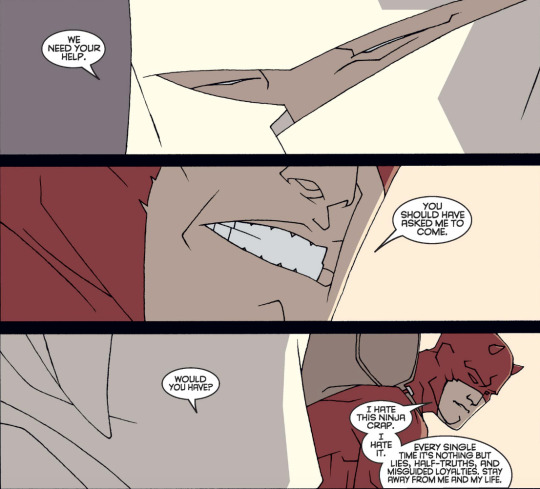
[ID: Excerpt from Daredevil: Ninja. A conversation between Daredevil and Stone in a series of face close-ups.]
Stone: “We need your help.”
Matt: “You should have asked me to come.”
Stone: “Would you have?”
Matt: “I hate this ninja crap. I hate it. Every single time it’s nothing but lies, half-truths, and misguided loyalties. Stay away from me and my life.”
Daredevil: Ninja #2 by Brian Michael Bendis, Rob Haynes, and David Self
There are also two excellent (and, I’d say, influential) alternate universes in which Matt joins the Hand and thrives in their presence: What If? Daredevil vs. Elektra and Earth-65 (Spider-Gwen-verse).
Lady Bullseye (Maki Matsumoto) And if we’re discussing the Hand and the Chaste, I have to mention Maki– undisputed head of the Bullseye Fan Club and another of my favorite Daredevil villains. She’s relatively new (she was introduced during Brubaker’s run) and so hasn’t had a particularly big long-term influence on Matt, but she is a great character with extensive connections to Daredevil history. One thing I love about her is the fact that while she modeled her look and identity on Bullseye, she isn’t treated as just female version of him, as her name might suggest. They actually have very little in common; she just chose to honor Bullseye because he played a role in her origin story by indirectly rescuing her from a human trafficking ring.

[ID: Panels from Brubaker’s Daredevil run. Bullseye is single-handedly beating up a bunch of gun-toting mobsters in a warehouse building. Maki Matsumoto watches him between the bars of a large cage.]
Caption: “She remembers that so vividly. Remembers the joy she beheld that day from her cage. She had never seen anything so beautiful, she thought. Of course, she was nearly insane already by then. But then, like a miracle… freedom.”
[ID: Maki reaches between the bars of the cage and grabs a key from a dead mobster’s pocket. As she tries to escape, another mobster runs toward her.]
Man: “You– back in your cage, girl!”
Maki: “I think not.”
[ID: Without looking at him, she slices his throat with the key.]
Daredevil vol. 2 #111 by Ed Brubaker, Clay Mann, and Matt Hollingsworth
Since then, Maki has teamed up with Bullseye– mostly notably, resurrecting and caring for him after his death in “Shadowland”– but more often, she operates on her own as an assassin. Like both Elektra and Matt, she was trained by the Hand and the Chaste without forming an official allegiance with either, and it seems her primary teacher was Master Izo– thus making her Matt and Elektra’s ninja aunt and/or sister in the Chaste Family Tree that definitely exists in my head and nowhere else.
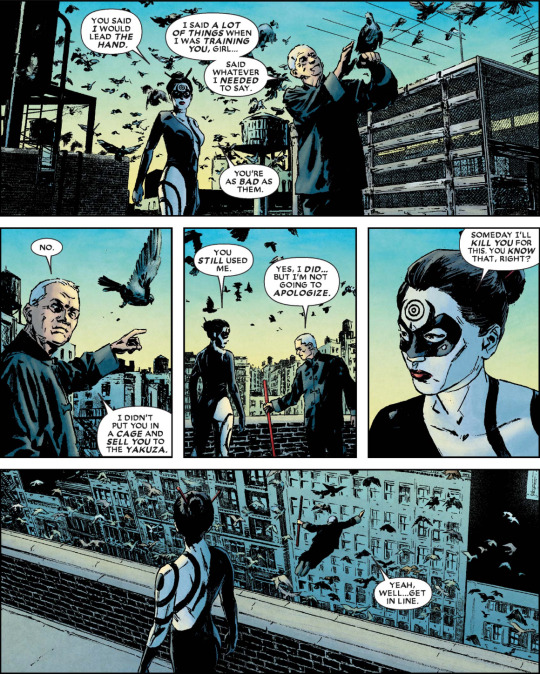
[ID: Excerpt from Brubaker’s Daredevil run. Lady Bullseye and Izo are standing on a Manhattan rooftop as the sky brightens behind them. Pigeons are flocking around them; Izo has one perched on his hand.]
Maki: “You said I would lead the Hand.”
Izo: “I said a lot of things when I was training you, girl… Said whatever I needed to say.”
Maki: “You’re as bad as them.”
Izo: “No. I didn’t put you in a cage and sell you to the Yakuza.”
Maki: “You still used me.”
Izo: “Yes, I did… but I’m not going to apologize.”
Maki: “Someday I’ll kill you for this. You know that, right?”
[ID: Izo leaps off the roof.]
Izo: “Yeah, well… get in line.”
Daredevil vol. 2 #500 by Ed Brubaker, Michael Lark, Stefano Gaudiano, Matt Hollingsworth, et al.
Maki masterminds the destruction of Matt’s life that leads him to join the Hand. She is extremely smart (she passes herself off as a lawyer during Brubaker’s run and fools both Matt and Foggy; as far as anyone knows, she might actually have a law degree…?), an excellent fighter (arguably better than Matt, not quite as good as Elektra), an absolute badass, and an all-around great antagonist who deserves her own solo series (hint, hint, Marvel).
Death-Stalker I’m not sure Death-Stalker counts as a major Daredevil villain, but he was used about once a week in late 70s Daredevil so he’s certainly been a recurring presence. I also just find him really cool, conceptually. One of the interesting things about Death-Stalker is that he started his existence as a completely different supervillain: the Exterminator, who is best known for “killing” Mike Murdock! The Exterminator had a weapon that could shift its victims out of sync with the time-stream. When Matt blows it up to fake Mike’s death, the Exterminator is caught in the blast, with shocking consequences:
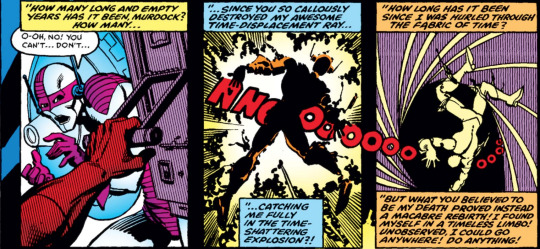
[ID: Excerpt from McKenzie’s Daredevil run. A series of flashback panels: the Exterminator (a kind of goofy-looking villain with a purple and white costume and blue antennae on the side of his mask) watching Daredevil pull a lever, then the Exterminator getting caught in an explosion and falling into a void.]
Death-Stalker: “How many long and empty years has it been, Murdock? How many… since you so callously destroyed my awesome Time-Displacement Ray… catching me fully in the time-shattering explosion?! How long has it been since I was hurled through the fabric of time? But what you believed to be my death proved instead a macabre rebirth! I found myself in a timeless limbo! Unobserved, I could go anywhere! Do anything!”
Daredevil vol. 1 #158 by Roger McKenzie, Frank Miller, and George Roussos
Thus, the Exterminator returns years later as Death-Stalker– a villain who can move freely through time and space, become intangible at will, and whose mere touch is lethal. This, combined with his new appearance (glowing eyes, bony hands, huge billowy cape…) makes for an excellent creepy character concept, and some of the Death Stalker issues feel more like horror stories than the typical Daredevil comic.
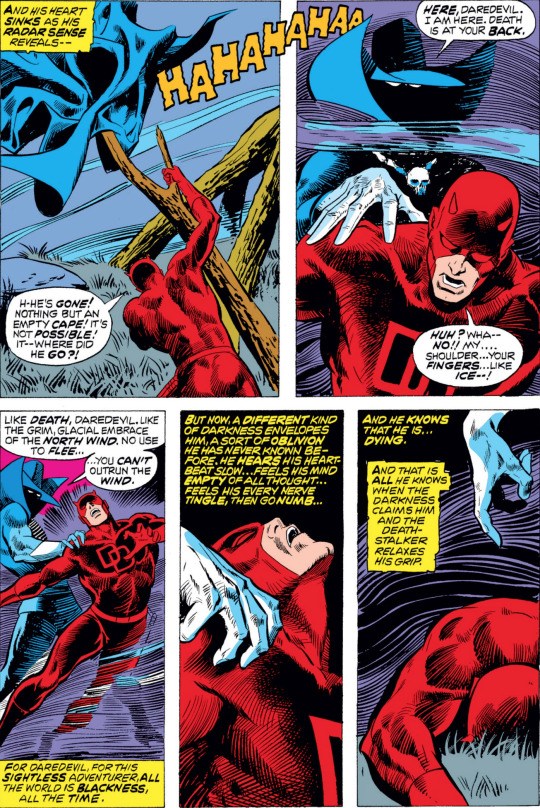
[ID: Excerpt from Gerber’s Daredevil run. A tired Daredevil is making his way through a swamp. Death-Stalker appears behind him out of the fog and puts a skeletal white hand on his shoulder. Daredevil collapses.]
Matt: “H-he’s gone! Nothing but an empty cape! It’s not possible! It– where did he go?!”
Death-Stalker: “Here, Daredevil. I am here. Death is at your back.”
Matt: “Huh? Wha– No!! My… shoulder… your fingers… like ice–!”
Death-Stalker: “Like death, Daredevil. Like the grim, glacial embrace of the North Wind. No use to flee… you can’t outrun the wind.”
Caption: “For Daredevil, for this sightless adventurer, all the world is blackness, all the time. But now, a different kind of darkness envelopes him, a sort of oblivion he has never known before. He hears his heartbeat slow… feels his mind empty of all thought… feel his every nerve tingle, then go numb… and he knows that he is… dying. And that is all he knows when the darkness claims him and the Death-Stalker relaxes his grip.”
Daredevil vol. 1 #114 by Steve Gerber, Bob Brown, and Stan G.
Sadly, though, I don’t feel he was ever used to his full skin-crawling potential, particularly considering how dangerous his power-set was. He was mostly just a nuisance who rarely got the upper hand, and he was killed in Daredevil #158 when he accidentally materialized through a tombstone during a fight with Matt. One of my favorite details about Death-Stalker isn’t Death-Stalker himself– it’s that his mother lived in a booby-trapped mansion and owned an army of exploding robotic children that she sicced on Matt to avenge her son’s death. But that’s a story for another post…
Jester (Jonathan Powers) The Jester gets no respect, and it’s a shame because he’s both genuinely a great villain when he’s used well and highly entertaining when his 1960s goofiness is played up, and he manages to embody both of those characterizations with absolute panache. He has played a role in some fairly major Daredevil stories over the years and I’d consider him a staple DD villain. His origin story is pure Silver Age silliness: he was an actor who received bad reviews for his first major starring role, found his career heading downhill, and so decided to become a supervillain instead. This is pretty typical of motivations for villains of this time period (see the Gladiator’s origin story above, and Stilt-Man below), but even this aspect of his character has been put to good use. Daredevil #218 features a surprisingly touching story of the Jester stealing the chance to reprise that first starring role– and of Matt keeping the cops distracted (by pretending to be the Jester!) so that his enemy can finally live his dream.
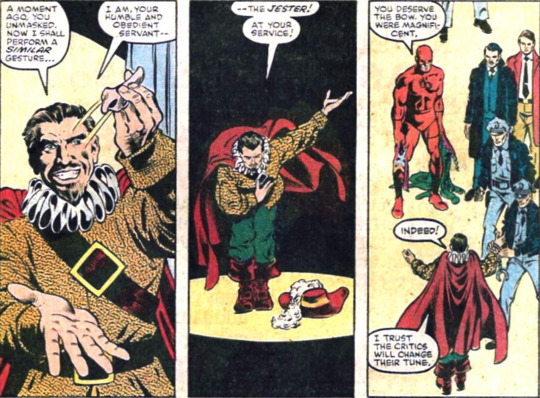
[ID: Excerpt from O’Neil’s Daredevil run. The Jester is dressed as Cyrano de Bergerac. He pulls off his false nose and bows dramatically to Daredevil and the cops who have come to take him in.]
Jester: “A moment ago you unmasked. Now I shall perform a similar gesture… I am your humble and obedient servant… the Jester! At your service!”
Matt: “You deserve the bow. You were magnificent.”
Jester: “Indeed! I trust the critics will change their tune.”
Daredevil vol. 1 #218 by Denny O’Neil, Sal Buscema, and Christie Scheele
Throughout the issue, Matt draws comparisons between himself and the Jester: their shared mask-wearing and the experiences of disillusionment that shaped their lives– and while it certainly doesn’t give the Jester the emotional depth of certain other Daredevil villains, it’s a memorable connection.
But where the Jester is at his most dangerous is not as an actor looking for attention– it’s as a creator of chaos. The Jester is a master of illusions and media manipulation. In his introductory arc, he frames Daredevil for his murder and turns Matt into a wanted criminal. Later, he uses a campaign of false news reports and misinformation to sabotage Foggy’s run for District Attorney, turn the superhero community into targets, and throw the whole country into an uproar. Most recently, in Waid’s run, he manipulated TV footage to cause rioting in NYC in the wake of an unpopular and highly publicized court ruling. His plans don’t always succeed, but even then, the scope and effectiveness of the damage he causes makes him a truly formidable villain.
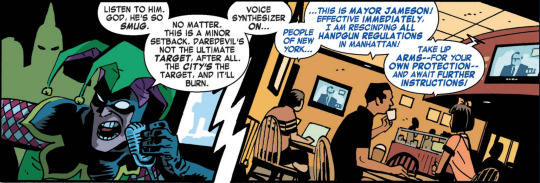
[ID: Excerpt from Waid’s Daredevil run. The Jester is sitting in front of computer monitors in a dark room, yelling into a microphone. In the next panel, we see random civilians in a cafe, watching “Mayor Jameson” (played by the Jester) on TV.]
Jester: “Listen to him. God, he’s so smug. No matter. This is a minor setback. Daredevil’s not the ultimate target, after all. The city’s the target, and it’ll burn. Voice synthesizer on… People of New York… this is Mayor Jameson! Effective immediately, I am rescinding all handgun regulations in Manhattan! Take up arms– for your own protection– and await further instructions!”
Daredevil vol. 3 #32 by Mark Waid, Chris Samnee, and Javier Rodriguez
The Owl (Leland Owlsley) The Owl has, unfortunately, been overshadowed by the Kingpin for most of his existence, and as such, hasn’t been given anywhere near the same amount of character development or nuance. They were created based on the same character concept: a high-powered mobster with a shadowy network of pawns who controls the city’s criminal underworld.
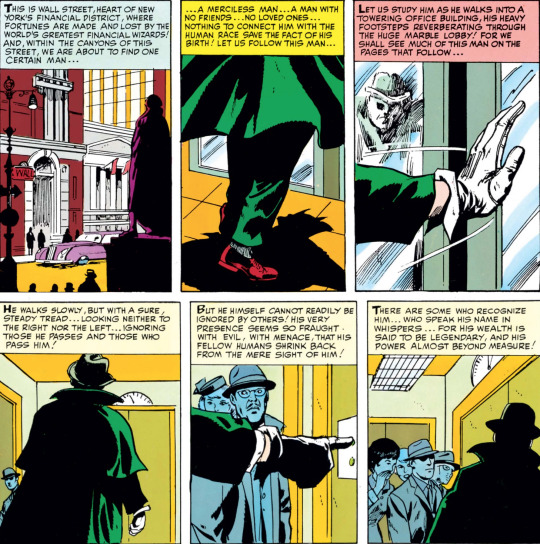
[ID: A series of panels from Lee’s Daredevil run, showing a man in a long green coat and brimmed hat walking into an office building. His face is not shown; the people he passes looked at him with fear.]
Caption: “This is Wall Street, heart of New York’s Financial District, where fortunes are made and lost by the world’s greatest financial wizards! And, within the canyons of this street, we are about to find one certain man… a merciless man… a man with no friends… no loved ones… nothing to connect him with the human race, save the fact of his birth! Let us follow this man… let us study him as he walks into a towering office building, his heavy footsteps reverberating through the huge marble lobby! For we shall see much of this man on the pages that follow… He walks slowly, but with a sure, steady tread… looking neither to the right nor the left… ignoring those he passes and those who pass him! But he himself cannot readily be ignored by others! His very presence seems so fraught with evil, with menace, that his fellow humans shrink back from the mere sight of him! There are some who recognize him… who speak his name in whispers… for his wealth is said to be legendary, and his power almost beyond measure!”
Daredevil vol. 1 #3 by Stan Lee, Joe Orlando, and Sam Rosen
Unfortunately, the Kingpin just ended up doing it better, and while there are a few Owl story arcs that I really like, I’ve never found him that interesting. However, he is hugely significant because he was the very first Daredevil supervillain, introduced all the way back in Daredevil #3! (In #1 Matt fights the mobsters who killed his father, and in #2 he fights Electro, who is a Spider-Man rogue.) Thus, he has had an impact on Matt’s life simply from having been around for so long. This also means there’s a huge range in his stories, verging from extremely ridiculous (he sometimes eats rats, and used to own an owl-shaped airplane. How cool is that?) to slightly more grounded. There is a great Owl story arc in which his bird-like body modifications start killing him, which gives his law-breaking more nuance, because he is doing it to look for a cure. Matt, upon discovering this, tries to help him.
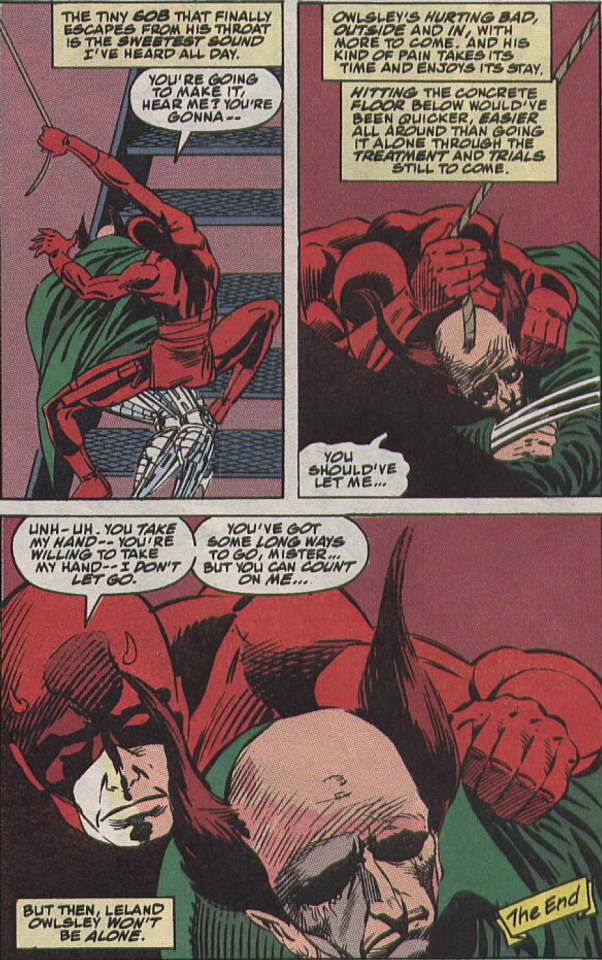
[ID: Excerpt from Chichester’s Daredevil run. Daredevil and the Owl are on a fire escape together. The Owl has metal cybernetic legs and has collapsed. Daredevil is comforting him.]
Matt: “You’re going to make it, hear me? You’re gonna–”
Owlsley: “You should’ve let me…”
Matt: “Unh-uh. You take my hand– you’re willing to take my hand– I don’t let go. You’ve got some long ways to go, mister… but you can count on me…”
Daredevil vol. 1 #303 by D.G. Chichester, M.C. Wyman, and Christie Scheele
There’s also great point in Bendis’s run when the Owl, in a surprising demonstration of cleverness, hires a lawyer to sue Daredevil for breaking and entering. It doesn’t work, but it throws Matt off and is absolutely priceless.
The Owl has also had several children– two unnamed young kids who were introduced in Alias, and Jubula Pride, who was introduced in Daredevil Volume 4 and worked alongside Matt to rescue her father. Jubula’s brief-but-memorable appearance added a bit more depth to the Owl– allowing us to see him in the role of a parent as well as a villain. But mostly, over the years the Owl has remained one of the more insidious of New York’s mob bosses, always scheming to stay in power and fight his way out of the Kingpin’s shadow. And he’s been doing it for so long that he feels like an integral part of Daredevil comics.
Turk Barrett He’s not a costumed supervillain or even much of a threat, but Turk has become an iconic Daredevil antagonist for both his sheer ineptitude and his plucky ability to stay alive. Of all of the recurring low-level mobster characters, he has the most engaging personality, and his dynamic with Matt is one of long-held friendly animosity. Daredevil isn’t the most dangerous person in Turk’s life, Turk isn’t the most dangerous person in Matt’s life, so they mostly just annoy each other. They’ve even been known to team up, when Turk thinks the odds of survival are in his favor.

[ID: Excerpt from Daredevil: Love and War. Turk Barrett (dressed in a white shirt and blue pants) is mopping the inside of an elevator. The doors open, and Daredevil walks in. They ride the elevator together.]
Matt: “Turk! You got the job!”
Turk: “No, man… this… I mean, I’m working undercover, man… I’m your backup!”
Matt: “I believe you, Turk.”
Turk: “Even know what level the doc’s on, man… So how’d you get in, Devil?”
Matt: “I flew in, Turk.”
Turk: “…Course. I knew that. ‘Spose the window locks weren’t much trouble…”
Matt: “Melted them with my heat vision.”
Daredevil: Love and War by Frank Miller and Bill Sienkiewicz
Turk is an underdog. He’s kind of a goof and he’s certainly a criminal, but he’s also a small fish in a big and dangerous pond, working in a career where most people eventually end up at the bottom of the East River in concrete shoes (or a taxi, as the case may be). He’s slippery and resourceful, he stays just harmless enough to keep himself out of danger, and you can’t help but root for him, even when he does dumb things like stealing Stilt-Man’s stilts or trying to kill Daredevil for the hundredth unsuccessful time.
Stilt-Man (Wilbur Day), of course, requires no introduction. He is another personal favorite of mine, and a rare case of a goofy Silver Age villain surviving into the modern era while remaining exactly as goofy as he was when first introduced. The great appeal of Stilt-Man is, in fact, that he’s a bit of a joke, while at the same time being quite dangerous, in a comic book physics-kind of way.
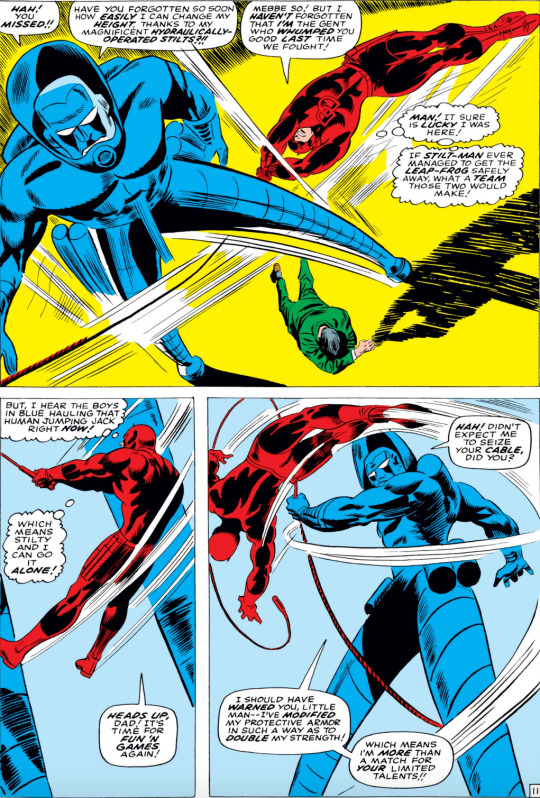
[ID: Excerpt from Lee’s run. Daredevil is battling Stilt-Man on a daytime city street.]
Wilbur: “Hah! You missed!! Have you forgotten so soon how easily I can change my height, thanks to my magnificent hydraulically-operated stilts?!!”
Matt: “Mebbe so! But I haven’t forgotten that I’m the gent who whumped you good last time fought! (Man! It sure is lucky I was here! If Stilt-Man ever managed to get the Leap-Frog safely away, what a team those two would make! But, I hear the boys in blue hauling that human jumping jack right now! Which means Stilty and I can go it alone!) Heads up, dad! It’s time for fun ‘n games again!”
Wilbur: “Hah! Didn’t expect me to seize your cable, did you? I should have warned you, little man– I’ve modified my protective armor in such a way as to double my strength! Which means I’m more than a match for your limited talents!!”
Daredevil vol. 1 #26 by Stan Lee, Gene Colan, and Artie Simek
Part of the charm of this characterization is the fact that he’s a joke in-universe as well; most of his appearances in modern comics consist of Stilt-Man being made fun of and/or of the audience being reminded that he’s actually a threat. This creates a great balance in his depictions; the jokes are fun, the sight of various superheroes being beaten up (at least a little) by Stilt-Man is fun, and he remains an enjoyable, mostly lighthearted presence in a landscape that has become dominated by Dark, Serious, and Disturbing villains.

[ID: Excerpt from Bendis’s Daredevil run. Matt is sitting at his desk in his darkened office, talking to Wilbur Day– a short, bald guy in a black jacket, with his arm in a sling.]
Wilbur: “Wilbur Day– I’m Stilt-Man. We’ve met four hundred times.”
Matt: “Stilt-Man– Huh. Oh, you mean that burglar guy Stilt-Man? Who wears the stilts and robs things?”
Wilbur: “Can we please just–”
Matt: “We’ve met when?”
Wilbur: “I–”
Matt: “Are you in some kind of legal trouble? Is that why you’re here?”
Wilbur: “Okay, fine.”
Daredevil vol. 2 #41 by Brian Michael Bendis, Alex Maleev, and Matt Hollingsworth
Stilt-Man is just a short guy in a ridiculous outfit who wants to commit some crimes and get a little respect– and really, who can’t relate to that?
Ikari (???) I’m mentioning Ikari not because he’s a long-established Daredevil villain– he’s not– but because I am fascinated by his potential. He’s a favorite of mine as much for what we don’t know as for what we do. In his introductory arc, we learn this: He was engineered/commissioned by Bullseye to kill Matt, his fighting abilities equal Matt’s, he has hypersenses, and (as a horrified Matt discovers later) he can also see.
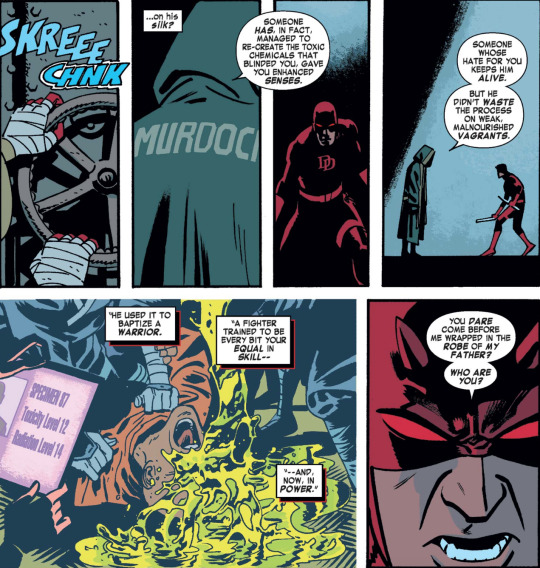
Ikari: “Someone has, in fact, managed to re-create the toxic chemicals that blinded you, gave you enhanced senses. Someone whose hate for you keeps him alive. But he didn’t waste the process on weak, malnourished vagrants. He used it to baptize a warrior. A fighter trained to be every bit your equal in skill– and now, in power.”
Daredevil vol. 3 #25 by Mark Waid, Chris Samnee, and Javier Rodriguez
And that’s it. We don’t know who he is or where he came from, or what the consequences are of having that degree of sensory perception (presumably his vision is heightened too?). We don’t know what his personal goals or motivations are, since we’ve only ever seen him as a pawn– first of Bullseye and then, later, of the Kingpin. But the concept of his character as someone who shares Matt’s powers plus some– who is essentially, skills-wise, a criminal version of Matt– and all the mystery that surrounds him, is hugely compelling to me.
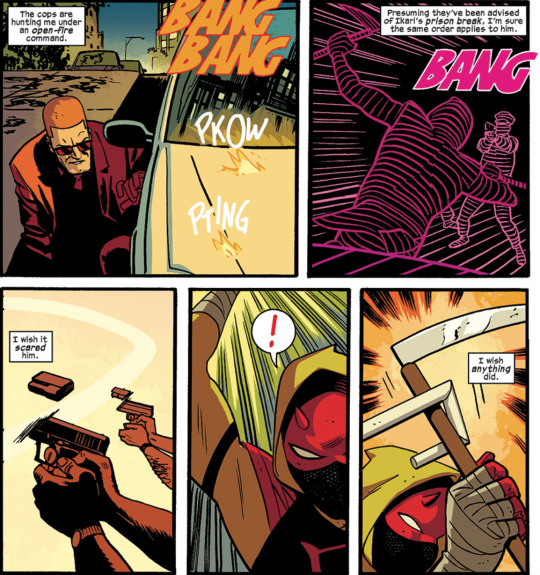
[ID: Excerpt from Waid’s Daredevil run. Both Ikari and Daredevil are out on the street, being shot at by cops. As Daredevil hides behind a parked car, Ikari attacks the cops and cuts their guns in half with his blades.]
Matt: “The cops are hunting me under an open-fire command. Presuming they’ve been advised of Ikari’s prison break, I’m sure the same order applies to him. I wish it scared him. I wish anything did.”
Daredevil vol. 4 #17 by Mark Waid, Chris Samnee, and Matt Wilson
In his last appearance he was killed by the Shroud, but his body was stolen, leaving the door open for him to maybe return sometime in the future and receive more development. I hope he does.
#soulfireinc#Gladiator#Typhoid Mary#The Hand#Lady Bullseye#Death Stalker#Jester#Owl#Turk Barrett#Stilt Man#Ikari#Asks#Adventures in Continuity
35 notes
·
View notes
Note
I think Sabrina is a little... questionable. I found the race depictions to be so problematic, in a way that tells me the showrunners thought that by casting a diverse cast they were done, when really they played into so many nasty race stereotypes and tropes that it ended up reading so offensive to me. (1/x)
For example, this show did not issue a trigger warning for an image of a lynched Black woman in 2018; it comes on suddenly and in close-up view. To do so without warning was so tone-deaf: It feels rare to go a day without seeing some news story about brutality against Black people. Showing it on a fictional TV show as one storyline of many felt like needless insult to injury, and it’s a telling marker of whose trauma is considered legitimate, and under what circumstances. (2/x)
It also seemed as if the show’s primary positioning of Prudence as an antagonist plays into a centuries-old myth developed by colonizers to dehumanize Black people for their traditional African spiritual beliefs and practices. The show positions Prudence as the angry Black woman who attacks the misunderstood, small, blonde, white girl. It’s a harmful conflict viewers simply did not need to see, especially when the cards are so clearly stacked in Sabrina’s favor. Prudence never stood a chance (3)
Representation is nice and all, but it should encourage writers to address characters of color like Prudence with dimension — including acknowledgements of how race affects the way they move through the world. Instead they totally ignored her race in some kind of colorblind haze, without acknowledging that even among women, power takes on a completely different meaning when blackness is a part of their identity. That to me is why CAOS is a bit of a failure. What do you think?—–
so, i’m definitely not going to dispute this. i mentioned in a few of my write ups for the show thus far that the treatment of race is never given any consideration the way sexuality and gender are cared for.
i get this especially in the arc for roz, who essentially functions as a plot device rather than get the same kind of character development that harvey, susie, and sabrina get, for instance.
as for prudence specifically, yes, the lynching scene has horrible optics and definitely perpetuates traumatic threats that were so unnecessary, in any case. it clearly wasn’t considered and i find it shocking (read: not too shocking) that no one, along the line, said hey, let’s not. you’d think that’d be obvious, but—it is RAS. he’s never been good at positive or equal racial representation, whatsoever, so let’s not beat around that bush.
beyond that, there are certain things that i feel i can’t speak to, but there’s a very good write up here, which i’ll post.
Prudence is never depicted as an outright villain. The writers behind the series clearly want audiences to like her: She has bombastic entrances, great comebacks, and a stylistic fierceness that honors Gabrielle’s inspiration from the iconic Eartha Kitt. For every scene where she is cruel to Sabrina, there are others meant to highlight her depth beyond that mean-girl archetype, like their thoughtful argument about faith in the “Feast of Feasts” episode. Even as they have wildly different perspectives, they learn to respect each other. For Sabrina, she is willing to disregard the rules in order to get freedom and power; for Prudence, power is enough. In many ways, Prudence reminds me of Buffy the Vampire Slayer’s Cordelia Chase (portrayed with vigor and venom by Charisma Carpenter) — a mean girl who becomes a hero with dimension in her own right.
I will admit whenever Prudence referred to Sabrina as “half-breed” to nod to her half-witch, half-mortal lineage, I winced. Those words coming out of the mouth of a black woman — especially a character who is revealed to be the mixed-race daughter of Father Blackwood (Richard Coyle) — is like stepping into a home with fun house mirrors. It’s a jarring occurence repeated at different points in the series, and it seems born from the same well of ignorance that led to the most prickly moment in the series’ fourth episode, “Witch Academy.”
The most controversial scene in Chilling Adventures, at least in regards to Prudence, comes at the end of that episode, which charts Sabrina’s early days in the Academy of the Unseen Arts as she suffers through a cruel hazing experience known as the Harrowing. The Weird Sisters, with Prudence guiding the way, relish torturing Sabrina — imprisoning her in a narrow chamber, forcing her into the cold night where a demon taunts her by imitating her loved ones being grotesquely tortured — and save their cruelest punishment for last. They take Sabrina to a clearing in the dead of night. A noose festoons her neck, rope binds her wrists. But instead of being strung up and perhaps even killed, Sabrina flips the script: With the help of the ghosts of Academy students killed during their own Harrowings, she flings up the Weird Sisters on invisible nooses, strangling them as she declares there will be no more hazing at the school. In a recent io9 piece, Beth Elderkin and Charles Pulliam-Moore critiqued this scene succinctly: “This should not have to be explained, but it is in extremely bad taste to depict black people being hanged on television without an extraordinary amount of context and care that make it clear that (a) the creators of the television show understand the significance of that imagery, and (b) said hanging serves a narrative point.”
Lynching is not a horror transcribed to history, but a present and vicious act. The goal of those that perform these monstrosities throughout the sickening history of this country is more than just pain or violence, it is to consign black people to utter oblivion. As the marvelous journalist Ida B. Wells said to a Chicago crowd in 1900, “Our country’s national crime is lynching. It is not the creature of an hour, the sudden outburst of uncontrolled fury, or the unspeakable brutality of an insane mob. It represents the cool, calculating deliberation of intelligent people who openly avow that there is an ‘unwritten law’ that justifies them in putting human beings to death without complaint under oath, without trial by jury, without opportunity to make defense, and without right of appeal.”
I wasn’t riled by what happens in Chilling Adventures, but I can see how it betrays an ignorance to the optics of the matter, even as the hangings are meant to evoke the history of witch trials leading up to the emergence of the Greendale 13 in the closing episode. Yet to call what happens a lynching is to strip actual lynchings of their tangled complexities and to willfully ignore the context of the scene in the series. Sabrina doesn’t kill Prudence or the other Weird Sisters; she was defending herself in the only way she saw fit to avoid her own demise. (This act also foreshadows the darkness Sabrina is willing to enact by season’s end.) Most importantly, Chilling Adventures from the very beginning treats Prudence as an alluring mean girl, not a villain meant to be punished. If anything, Gabrielle brings her to life with such fierce grace, she becomes more than just a charming supporting character, but an accomplished scene-stealer who at times could be a more engaging anchor for the series than Shipka’s Sabrina.
[…]
Meanwhile, the history of black witches in pop culture is a tangled one defined by exoticization and marginalization. Black witches may be granted style and grace, but rarely are the written with any interiority. In The Craft, Rachel True’s Rochelle is mired in the racist attacks of a peer, but she is hastily drawn in comparison to the other, white members of her coven. In American Horror Story: Coven, Angela Bassett brings a fierce grace to Madame Marie Laveau, one of the most important figures of witchcraft in New Orleans and American history, but that series framed race in a way that betrays a queasy ignorance (and her power often paled to that of the white witches, who seemingly cribbed their skills from black women in the first place). Although Tituba is one of the most iconic black witches, thanks to portrayals in a variety of books, films, and series about the Salem witch trials, historical documents prove she wasn’t black at all but a South American Native. The most successful black witches in all of pop culture, to me, remain Mozelle Batiste Delacroix (Debbi Morgan) and the women of Eve’s Bayou, a gorgeous coming-of-age tale that respects and celebrates the rich culture of rural Louisiana.
Where does Prudence fit within this lineage? Does she mark a fascinating step forward in granting black women (and black audiences by proxy) the delight that comes with being a witch, or is she another example of the ways black witches in pop culture garner little respect and even less interiority by the writers that conjure them? Prudence is a tremendous character — beguiling, sharp-witted, fierce. She’s also something I wish I got to see as a kid: a black witch having fun with her powers and reveling in the world she lives in. If anything, she’s dynamic enough thanks to Gabrielle’s slinky performance that she trumps the show’s nagging issues of colorblind perspective. The creators behind Chilling Adventures would be smart to give her even more focus going forward and define the dynamics of race within their world of witchcraft.The conversation swirling around Chilling Adventures reflects the fascinating, wildly shifting intersections between politics and art that often simplify the former and flatten the latter.
Representation need not be a mirror for individual members of the audience, but should encourage writers to address characters of color like Prudence with dimension — including acknowledgements of how race affects the way they move through the world. Chilling Adventures seeks to interrogate the ways women yearn for, experience, and at times, are prohibited from power through its clever, rich story about witches. But to give this story justice, the show must acknowledge that even among women, power takes on a completely different meaning when blackness is a part of their identity.
[x] (i think the whole article is really great and worth reading too)
so for me, yes, caos absolutely fails in many regards. it’s very whitefeminism!now! and that’s clear.
but i do really agree with the last part of this article as well, which highlights that prudence is a very strong character in her own right and her relationship with sabrina very much shifts; before the show aired, i mentioned i was nervous that they made sabrina’s foil a black girl, but as it progressed, i didn’t really feel prudence was an antagonist. at the start, sure, but she feels very much a victim to the same world (for different reasons, obviously) and seemed to realize that towards the end. how she addresses her place in the witch world as a woman of color is something i hope the writers are paying attention to. i hope.
witches are always going to be fairly fraught in terms of subject matter; caos invokes so much catholic vs satanism that it absolutely stomps all over any other religion, particularly iconography or stereotypes. i have plenty of criticisms in this regard, especially from my own place as a jewish woman. so many western witch stereotypes come from anti-semitism. the pointed hat was a medieval jewish hat and the physical depiction of witches also comes from very aggressive anti-semitic stereotypes, as well as the stories of blood libel (ie, child snatching and eating). it goes on.
still to this day, most witches in films are portrayed by or described as jewish women. (elphaba, the witches in any oz incarnation, the coding of mother gothel in tangled etc) in caos specifically, they utilize lilith, who was a jewish figure, as the original demon and i could see that upsetting some in the context. it doesn’t for me, as a jewish woman, but i get it.
and yet, i still enjoy the exploration of the witch, because i think it has the capacity to move or wade more deeply into these historical contexts, and also can be steeped with so much other meaning as well. witches have often been a gendered issue, the vilification of the woman, and how that spills onto the woman’s individual non-christian or non whiteness is a case by case basis. caos definitely, definitely fails in this.
tl;dr, i do agree. i really do. and these are critiques that make the show worth not watching for some, worth openly pointing out. race is just as wrapped up in witch tales as much as religion or gender is, so to only address two out of those three things felt deliberately “colorblind” in a way that is not effective (and straight out offensive) for where we’re at in society.
12 notes
·
View notes
Text
books 2017 finale
this is almost brief.
december: The Lying Game - Ruth Ware Every Heart A Doorway - Seanan McGuire Saving Morgan - MB Panichi Call Me By Your Name - Andre Aciman City of Fallen Angels - Cassandra Clare City of Lost Souls - Cassandra Clare (see below) Barry Lyndon - William Thackeray Into Thin Air - John Krakauer
that was the brief part, this is the ‘almost’ part. 279 for the year, up from 188 last year.
Why Did I Ever - Mary Robison fiction, re-read, it is a delight always.
Binti - Nnedi Okorafor fiction, I read a couple of other interesting explorations of "what does it mean when I am more like the monster than the hero?" which is pretty astoundingly generative as a genre, this was my fave. Binti herself explores two alien cultures, and reacts in practical ways to the unexpected, which is always a delight in a heroine. Space is strange; let us not dwell on realism, it's a different real. This willingness to abandon what does not work is characteristic of young women. Young women are great sff protagonists, and young women of historically-disadvantaged backgrounds who are incontestably heroic are the greatest sff protagonists of all.
The Thrilling Adventures of Lovelace and Babbage - Sydney Padua art, complex and excitingly rich alternative history, which not only explains computing history but also, at the last page, yanks at the heart of anyone who has ever yearned. The art is propulsive and antic, and the visual puns are very good. (not to be missed: the encounter with Queen Victoria!) Even I, a person who is bad at reading graphic novels, loitered over the drawings to understand them rather than reading the words and flipping the page.
IQ - Joe Ide fiction, what Sherlock Holmes would actually be like in a modern novel. A loner in a big important city who feels that he has much to make up for, check the convincing depiction of depression, and the real nightmares who actually do fall short in the world's estimation, except that the world is too busy to notice them at all. The main thread is a fun romp, and the minor characters are so exquisite that it is almost a picaresque. I was talking about this loudly on a train, and when I and it stopped, a man came up to me and asked if I could give him the title again as he wanted to buy it. TRUE.
Hild - Nicola Griffith fiction, on the recommendation of @inclineto This is what historical fiction should be like: it's not that this was somehow better than everything else, it was merely relevatory. Historical fiction can be about religion, power, families, war and how to card wool. (You don't have to pick if you are an inside or outside person! Girls, you can be both Thayet and Buri!) The protagonist can be cheerfully bisexual, too. It's as though all of the novels we have determinedly pretended were about gals being in love with other gals came true, and also the heroine gutted bad guys and was eventually canonized.
Everything is Teeth - Evie Wyld and Joe Sumner art, teeth were a big theme this year (as ever) and this is the one where a) no one talks about the shameful inequalities in provision of dental care to children in the United States and b) no one fucks a fish. just letting the distinguished reader know that I have a selection process for what I read, I can see how that might not be clear. I would be delighted to talk about a) and b) mentioned here, or anything else I read this year.
Water Dogs - Lewis Robinson fiction, re-read, always always. the person who loves novels about well-off and unusual families falling apart in opulent squalor either literal or metaphoric and maybe murder? that person is tuv. Inexplicably, no part of this was ever published in The New Yorker.
Margaret the First - Danielle Dutton fiction, on the recommendation of @elanormcinerney The subgenre of “garrulous historical person in his or her own words" is becoming something of a crowded field (Ruth Scurr's book on/with John Aubrey is the other best entrant, there are others) and the artistry involved in this example is particularly fulfilling. This is smart and I remembered all the stuff about science and poetry that Arts & Letters Daily is always trying to teach me. That's why to read women, among other reasons. The smarts.
Blood in the Water - Heather Ann Thompson non-fiction, persistent mismanagement, gross racism, and inadequate communication turn out not to be the way to run an organization. This is really a masterpiece of microhistory, about the Attica Prison Uprising, and the ways in which people in power blind themselves to consequences of their actions, while the people who suffer the consequences of those actions suffer and continue to suffer.
See Under: Love - David Grossman trans Betsy Rosenberg fiction, goes well with the Quay Brothers' "Street of Crocodiles," while we are talking about Bruno Schulz. I read parts of it in my head to the neighbors' dog. the dog understood. my voice would have shredded with sadness if I had spoken. thanks, Astro, for being there.
Sarong Party Girls - Cheryl Lu-Lien Tan fiction, this is the novel that Kevin Kwan isn't tough enough to have written. It's about how grown-ups deal with the consequences of their actions, and also about drinking with pals. A person can be both of those things, and Jazzy is that, and more.
Emotionally Weird - Kate Atkinson fiction, a strong taste for the picaresque, and a crystalline capture of youthful aimlessness and disorder even as it is being shaped by larger forces. Effie wanders through words and life, and I had a wonderful time with this one summer afternoon. No one else appears to have much liked this book, other people are wrong, it's funny. It is profoundly show-offy and unrelateable to play parlor games in the car, say book reviewers with terrible personalities -- sounds like someone lost a game of fives recently. (I’m very good at the game of fives, and I did not quite feel personally criticized when this book was unpopular, if only because I have my expertise at ‘name five mountaineers who did not climb Mount Everest’ to console me.)
A Line Made By Walking - Sara Baume fiction, I just really love books about depressed women acting as they see fit.
Chemistry - Weike Wang fiction, I just really love books about depressed women acting as they see fit.
The Gentleman’s Guide to Vice and Virtue - Mackenzi Lee fiction, recommended by @mysharkwillgoon see "Hild" above, books are just better when the main character solves problems and kisses everyone. This is how historical romances should be, this is what we have all received for those years of crossing our fingers under the cover of a Heyer and hoping 'maybe he'll love his best friend! maybe she'll tell her cousin what she really thinks!" and they DO. and then they escape from pirates, “The Monk,” and robbers.
Raven Rock - Garrett Graff non-fiction, read this first and then think about how we all got from there to a study of underground bunkers and the places where some of us were going to go when the rest of us died. Offutt AFB is along the way, which only served to remind me that I have family in Nebraska and I live in fear of the day when one of them does some casual genealogy and we have to talk; "so. your state. big in the planning for our forthcoming and yet reucrring nuclear crisis, howdoes that feel? feels powerful and also sickening, yeah? anyway, your great-aunt's ashes aren't scattered in the Lincoln Tunnel, but we thought about it."
The Art of Charlie Chan Hock Chye - Sonny Liew art, here is what we are up against. The theme this year appears to have been "weeping at what could have been." This is a first rate textbook, and a cunning subversion of the whole notion of textbooks. I learned a great deal from this; had I learned nothing, my eye would still have wandered along, marvelling at the layout. There are several overlapping stories about narrative, success, and Singaporean history, yet the metatextuality (horrible word, apologies) is never confrontational. Which is truly a pleasure.
The Story of a Brief Marriage - Anuk Arudpragasam fiction, this is the book I've been telling everyone about as my fave book on the year. Only the most literary of adjectives will suffice: brutal, lyrical, lambent, noctilucent, I'm just typing words.
The Unwomanly Face of War - Sveltana Alexievich trans Richard Pevear and Larissa Volokhonsky non-fiction, more incisive than more recent collections, and in a shimmering translation. Pevear and Volokhonsky have tossed words out like diamonds on black velvet. The rare wartime history that is more appealing without a map.
City of Lost Souls - Cassandra Clare oh give me a fucking break, Jonathan nee Sebastian brainwashed Jace nee whatever while they were in the magical flying Gormenghast pied a terre, they absolutely schtupped.
8 notes
·
View notes
Text
You know what the stupidest thing about the whole ‘Spider-Man is about youth’ thing is?
Most people who have gotten into Spider-Man first discovered him through some form of media or merchandise outside of the comic books.
Toys, a t-shirt, TV shows and the movies of course.
And therein lies the utter nonsense of Spider-Man needing to be a high schooler in order to be relatable and appealing to mass audiences.
If your first exposure to Spidey is seeing him on a t-shirt, or on a lunchbox, or as an action figure line chances are you haven’t the first inkling as to his age.
In fact between the 1960s and the 1990s (maybe early 1980s) the dominant rendition of Spider-Man used in all merchandise was Romita Senior’s rendition which was based upon a college aged (we’re talking 19-20, 21 at a push) Spider-Man.
And that was used to sell Spider-Man in merchandise regardless of the fact that the character from the mid 1970s-the late 1980s was no longer in that age range. in fact come the mid-late 1980s Peter Parker wasn’t even in full time education anymore so using a college aged Spider-Man in merchandise didn’t make sense. Or I guess having him NOT be college aged like the merchandise really didn’t make sense.
Except it did because shockingly seeing this image on a t-shirt...

Doesn’t pin the character down as either 19-21 nor 22-25 nor 35+ because the costume if effing ageless.
AH but when they get to consuming actual STORIES about Spider-Man then his age WILL become a factor because they WILL be able to clearly tell if he is a teen, a college student or a fully grown married adult right?
Yes, but putting aside how by that point they’ve already tuned into or purchased a Spider-Man story anyway it still puts to bed the lie that he NEEDS to be a kid to attract an audience.
But lets run with the idea of consuming actual stories.
Lets consider how most people alive today who LIKE Spider-Man (regardless of whether they follow the comics or not) got into the character.
The answer is through the movies or the TV shows.
In fact whatever you might say about it’s quality overall, the 1960s Spider-Man cartoon was influential enough that it’s still seen as the defining piece of music related to Spider-Man.
For children (and maybe some teens) of the 1980s Spider-Man and his Amazing Friends WAS Spider-Man.
For folks of my generation there can simply never be a truer rendition of Spider-Man than Chris Barnes in the 1990s television series.
And I’m sure for better or worse at least some people got greater expisure and maybe interest in Spider-Man due to the Shoddy as fuck Spider-Man Unlimited cartoon and the CGI MTV series.
But by leaps and bounds the original Sam Raimi trilogy takes the cake. Those movies, especially the first one, shot Spider-Man up to new heightes of pop cultural awareness.
Before the 2002 film people who’d never seen or read any Spidey stories (we’re not counting the poor parents of kids who watched the cartoons) could clearly identify him if they saw his costume and knew he could stick to walls and swing from webs and hey maybe they knew he was Peter Parker and (at a big push) could MAYBE identity Doc Ock and Venom. After the 2002 film EVERYONE knew Spider-Man was Peter Parker, that his Dad was Uncle Ben, that his mother was Aunt May, that he loved Mary jane, that his best friend was Harry, that Harry’s Dad was his enemy, that he worked for the J. Jonah Jameson of the Daily Bugle taking selfies and that he got his powers from a spider bite, those powers including super strength and agility.
Come the sequels everyone now knew who Doc Ock and Venom were too and that Harry followed in his Daddy’s footsteps.
And what might we ask do all those adaptations barring the 1960s show (but including the forgotten 1970s Nick Hammond experiment) have in common?
None of them are about a high school aged Spider-Man.
Oh, the 2002 film starts with a high school Spider-Man. But when we say he was in high school we mean for like the first half of the first movie where he was months away from graduating.
In fact even in the 1960s show Peter might have been in high school but it boiled down to more of a point of background trivia than anything. Peter sounded like a grown man in the show and precious little time was shown depicting him in school or going through typically teenage experiences. Mostly the show relied upon the Bugle as the main place for Peter to hang out wen not in costume and relied upon him getting into costume ASAP so the action (such as it was) could start.
So yes that did present a teenaged high school version of Spider-Man but not one for whom that was particularly emphasized. he was more or less a generic superhero except he lacked a batcave but did instead have an elderly aunt.
Hardly a life situation that a teenager, or a 8-12 year old (who allegedly Marvel actually want a their core readership) would relate to beyond perhaps the parent/child relationship with Aunt May but even that’s tenuous, a 12 year old wouldn’t have the same relationship with their mother as Peter had with May in the show).
The idea of an 8-12 year old relating to all those other Spider-Man adaptations becomes even more ridiculous once you realize that in half of them Peter is living away from home (either on his own or with roommates) and is clearly over 18, i.e. an adult. And he does adult things like go out on dates (or tries to), tries to earn money, worries about his sick mother, and goes to college which just in the way it’s talked about and looks on screen and how the classes play out is clearly giving off a different vibe to a high school setting.
Yes some adaptations still had him living at home but again, his relationship and dynamic with Aunt May was simply not the same as what the dynamic between an 8-12 year old kid’s would be with their parents. When you are that age your parents are the dominate authority figures in your life (whether you kick back against it or not). For a college aged man, even a young one of 18-19, Aunt May isn’t an authority figure and the shows clearly conveyed that.
In the 1994 cartoon Peter briefly moved out in the first season and was shown to look after Aunt May more than once (including in the first episode). in the iconic Alien Costume three parter he even shoots down May’s suggestion to stop taking Spidey pix.
No little kid seeing that saw themselves in Peter and their relationship with their parents in Peter’s relationship with Aunt May.
Perhaps the most adaptation where Peter’s life as an independent adult was clearly conveyed was Spider-Man 2. The whole movie is the aggressively NOT a coming of age story. That was the first movie.
Spider-Man 2 isn’t a coming of age story it’s about learning how to manage and come to terms with the push and pull of adult life and who you are within that.
Honestly the only thing that a kid could even possibly relate to in that movie is when Curt Connors gives Peter a dressing down and when Harry is upset with him. Kids have teachers and authority figures who take them to task and they fall out with their friends too. MAYBE they could relate to his falling out with MJ for the same reasons but it’s devoid of the actual point of those scenes, the romantic emotions that underpin them.
Beyond that Spider-Man the superhero that Marvel desperately want 8-12 year olds to love and follow deals with rent, romance, crappy accommodations, and rather complex emotions related to his dead Dad and his grieving mother. All whilst he battles a guy who he used to look up to but ho’s wife just died.
You know, all the stuff kids and teens could obviously relate to.
Except they couldn’t because no kid or teen deals with that kind of stuff.
And yet...kids and teens fucking LOVED Spider-Man 2.
Much the same way kids and teens in 1980 fucking loved SUPERMAN II which was another super hero movie about another character dealing with another set of adult romantic issues that involved him also forsaking his role as a hero only to readopt it later...And he was clearly even older than Spider-Man. Shit, you straight up see Superman and Lois Lane in bed together in that movie, which (hopefully...dear God hopefully) no kid would relate to. An adult man and an adult woman sleeping together in the same bed? That’s not them being represented on screen, that’s their parents.
But they still loved it. Much as they still loved MOST Spider-Man adaptations that didn’t portray him in a lifestyle that close to their much at all.
In fact if we really, really ,really cut the shit to an 8-12 year old kid watching 18+ year old college student Peter Parker (who usually lives away from his mother figure), who is clearly interested in romance and also has to earn money...Spider-Man is an adult.
MAYBE they recognize he’s not AS much of an adult as Superman or Batman.
But he’s an adult all the same.
Because to an 8-12 year old once you are tall enough and are interested in romance and a job and going to college and not living with your parents anymore your an adult.
Hell when I was like 3-8 years old I could tell the Power Rangers were going to school but I didn’t relate to them because of that. Because just from how they looked and what they did besides going to school they were adults to me, like older brothers and sisters or something.
The same was true of Spider-Man.
He might literally have been a YOUNG adult but to a child there is precious little difference between him going to college, the Power Rangers going to high school, Superman going to work at the Planet and Batman having Robin as his ward.
They are all essentially characters who fall under the banner of ‘adult’ in the mind of a child.
And yet despite essentially seeing Spider-Man as an adult they couldn’t relate to children of multiple generations have continued to love Spider-Man and become interested enough to sometimes follow him into the comic book pages.
Because Spider-Man’s appeal is partially a thing of magic maybe nobody can fully understand and partially because yes he is relatable but because of his PERSONALITY not because of the specifics of his life situation.
Hell, the success of characters like James Bond, Batman, Wonder Woman, Superman, Wolverine and Daredevil rather eviscerates the notion of characters needing to even BE relatable to most people to be popular and successful.
I personally relate to Superman more than Spider-Man in many ways but as a character Superman is...well it’s in his name. The central idea and appeal is for him to be a powerful human who is stronger and faster than anybody else, impervious to pain and can even defy gravity.
James Bond/Wolverine and Wonder Woman are quintessential male and female power fantasy figures, the latter two (especially Bond) being indulgent about that.
Daredevil is blind and that fact is integral to his whole set up despite most audience members reading or watching his stories obviously NOT being blind people.
By and large Batman is a wish fulfilment fantasy character who is at least AS popular as the more relatable Spider-Man and WAY more popular than Robin who was literally created to be the audience surrogate figure.
Long story short:
Spider-Man can and has repeatedly been able to appeal to mass audiences to immense critical and financial success regardless of what age he happens to be and what his life status quo in regards to his age might be.
So insisting his gimmick and purpose is to be young and a high schooler and that is the best way to optimize his success is profoundly idiotic.
#Spider-Man#Peter Parker#Spider-Man the movie#Spider-Man 2002#Sam Raimi#Spider-Man 2#Daredevil#Matt Murdock#Batman#DC#DC Comics#Marvel#Marvel comics#James Bond#007#Wolverine#James Howlett#james logan howlett#X-Men#Wonder Woman#Diana Prince#Bruce Wayne#Robin#Dick Grayson#Aunt May#May parker#MJ Watson#mjwatsonedit#Mary Jane Watson Parker#mary jane watson
100 notes
·
View notes
Text
youtube
I disagree at least one aspect.
How about this I've been thinking about introducing a character who is male and uses a traditional form of Viking magic that was noted to make or require men to act or appear as women this is Even tied into certain myths about Odin and how he was presented.
This however would understandably change both the history presentation and what have you of the Asgard in Marvel Comics. This is very important because if we want ad and more gay characters then we by necessity add in the entire identity of being gay. And with that gay subculture, gay history, and gay politics. All of which is going to be relevant in one degree or another to their life. And some of this stuff isn't directly political just so much as it's so in congruous from common assumption that it's going to be in contrast and conflict to both the established narratives of the fiction and the expectations of the audience
This is going to be necessary point. A need for this Single Character to be a gateway to Gay Culture or gay lifestyle where previously none existed for the world.
But this isn't just a burden it's also an opportunity I mean how have or how do the Asgard and Marvel Comics handle people being gay? In fact because of how gay has been erased in our society and how it by its own existence undermines a lot of social narratives kind of requires a more nuanced and complex way of viewing the world just to bring up even if the basic idea is very simple to get across - the idea of someone preferring their own gender in terms of romantic Pursuits. But that often has a knock-on effect with the number of people who we know for one thing also actually being gay. And this isn't just surface-level sketches. I mean remember finding Mary Poppins? The author of that book was a lesbian but in a supposed true story biopic this wasn't depicted. Erasure is a phenom a gay character contends
This is kind of the problem with increased representation it by necessity means disturbing pre-established narratives. Unfortunately this likely means your character is going to be or highly defined by their own Identity or have to import a lot of pre under stood identity politics or social narratives just by being a focus of distinction.
Now personally I think superhero comics are not well suited for this because a core of their appeal is action as opposed to drama or Romance. Having a coming-of-age drama deal with the fact that one or two or all of your characters are not straight or cisgendered is completely easy. After all the change of identity as you come to yourself as a large part of coming-of-age drama, so learning that you have an attraction to the same gender or that you may have be different gender expression easily slots into the beats and expectations of that
Unfortunately action-based conflicts don't exactly allow or are not well suited for dealing with struggles with being a minority even if you're past the hardships that are so going to inform where your character ended up in life. Not every person who's gay has trouble with their parents. But it's at the very least a very common and unique circumstance. There's going to be history there.
there's going to be weight there and it's such a large part of the gay identity that a large part of gay identity literature and politics centers around this reality. For instance part of the reason why intersectionality in terms of social justice or socialism has such a gay bent is because the implication that you can rely on traditional support structures such as church or family is not something that can be safely assumed if you've been gay for the last 50 years. There have been active campaigns to get rid of support network and infrastructure for gay communities. Or just dismissal so subject to crime and abuse. And traditional mainstream ones have actively excluded them such as the conflicts with the Salvation Army or other homeless shelters.
This is despite the fact that if you were a teenager and homeless chances are it's because you are LGBT and you've been kicked out of your home. This is especially important as you try to tackle social issues as a means of conflict and superheroes have been doing that longer than we've been recasting this character or that character as gay or black.
Finally there's just the fun in world-building what kind of gay community exists in a world where Captain America has been real since World War II. Has there been for instance at Revival of pagan beliefs with the onset of Thor? What kind has there been in what relationship do the asgardians have with it? They started to address some of this in one of the reboots of Thor but admittedly that was how they conflicted with conservative Christians in the Midwest. How do the actual Pagan face revivals that have been happening in Scandinavian countries intersect with the arrival of the MCU asgardians not least of which they don't fit the traditions and faith but may have inspired them or rip them off
These are all interesting plot threads but they grow from drama and not action. So I think in some ways superhero comics are trying to transition from action to more alternative Fantastical dramas. And considering that's been a big draw in terms of television and movies from Game of Thrones to Supernatural to God knows what else such as the Hunger Games Twilight The Vampire Diaries
and finally yeah some traditions do need to be attacked. The idea that everyone is straight except for a few crazy people who are gay who we should ignore at all times... it's probably at the heart of a lot of abuse. Whereas assuming queer Theory as a foundational truth meaning that not everyone is straight and gender and sexuality don't work as they have been traditionally thought of it's probably an okay thing especially as it's something that's understood to be the reality of the current zeitgeist as well as the audience.
Even people who consider themselves straight likely have had one or two phases of bisexuality or experimenting with gender. At the very least it's easier because everyone can pick a female Avatar. Or activities that are associated with being feminine are thought of as more gender-neutral such as fashion makeup romance or what have you
at the very least tapping into this thing that the young which is a major part of comics, it can't always just be to old people and how they see the world, it's important to give that a chance. especially as sexuality and gender identity are actual character traits whereas race is a bit more superficial unless we're talking about Heritage or more along the lines of ethnicity. for instance take Kamala Khan, for the most part I think she's a good character. Now there are bit pieces where things feel a little on-the-nose but it is very much aimed at a younger audience that comes from an ethnically diverse neighborhood they probably want someone to address the racial tensions that they've grown up with not least of which have been the issues with how Muslims are perceived and how their own culture and traditions have a plurality under a dome that's often reacted to hostilely
Finally some of its just adjustment both for the fans and the authors. I mean how did you really feel about Miles Morales when he first started? how did people react to him? you needed time to adjust to the idea that Peter got killed off and replaced with this guy who was very deliberately something of a token hire. and Brian Michael Bendis needed time to actually write a distinct character with his own feel and interesting ideas
finally listen to the music that kids are listening to ,read the web comics that they follow, or the Twitter discussions that they do and especially the manga that they're following and how they discuss it. I really do think that if we want Comics to remain they're going to have to change and one of those changes are going to have to be how they can appeal more to modern audiences, females, and yes trans
And some of this is going to require the characters in the world that they inhabit change in terms of assumption and presentation. There need to be gay and trans people as a community in a society that's so obvious that it's something that you discussing kindergarten without it being treated as exposing them to porn
0 notes